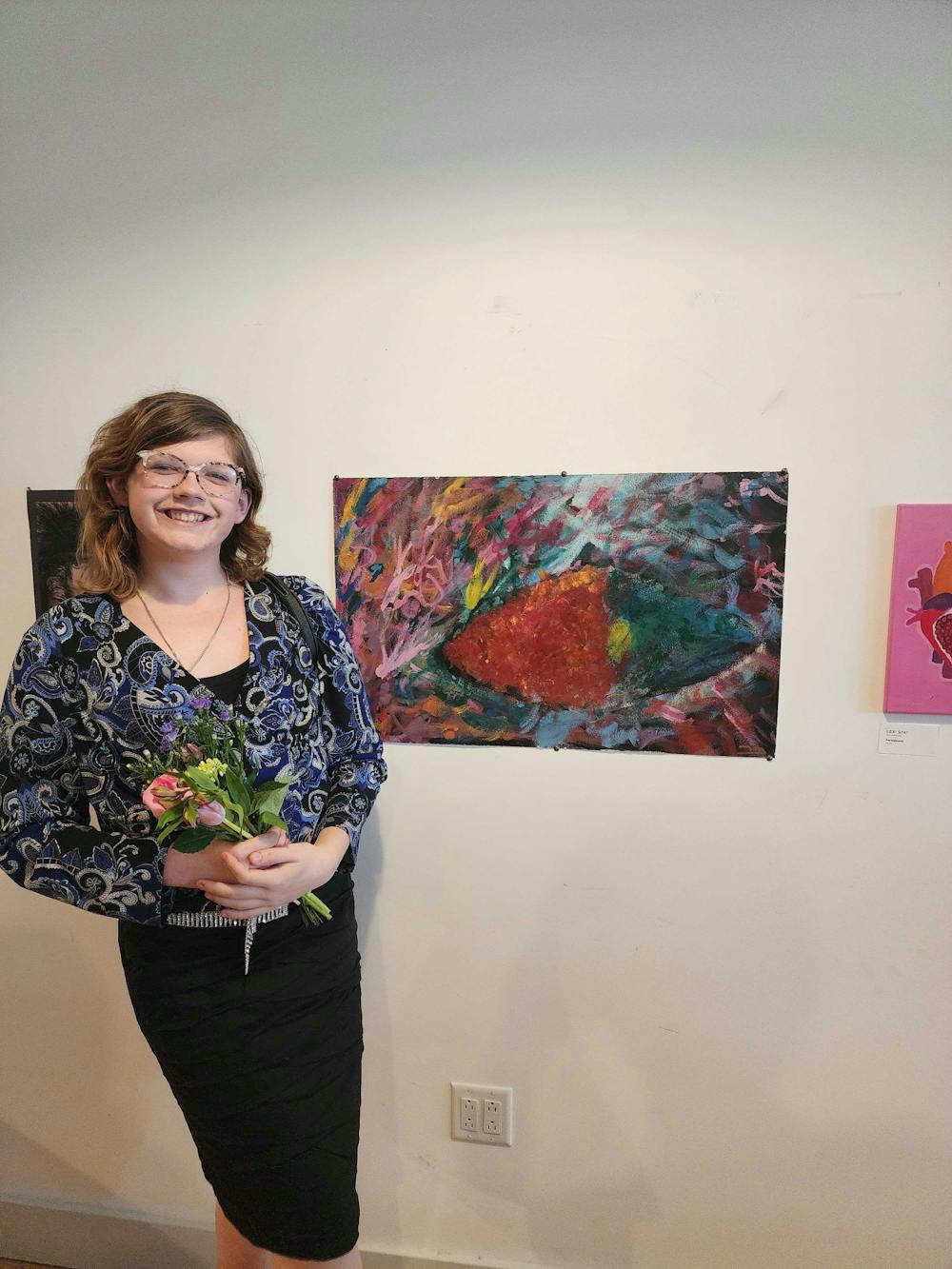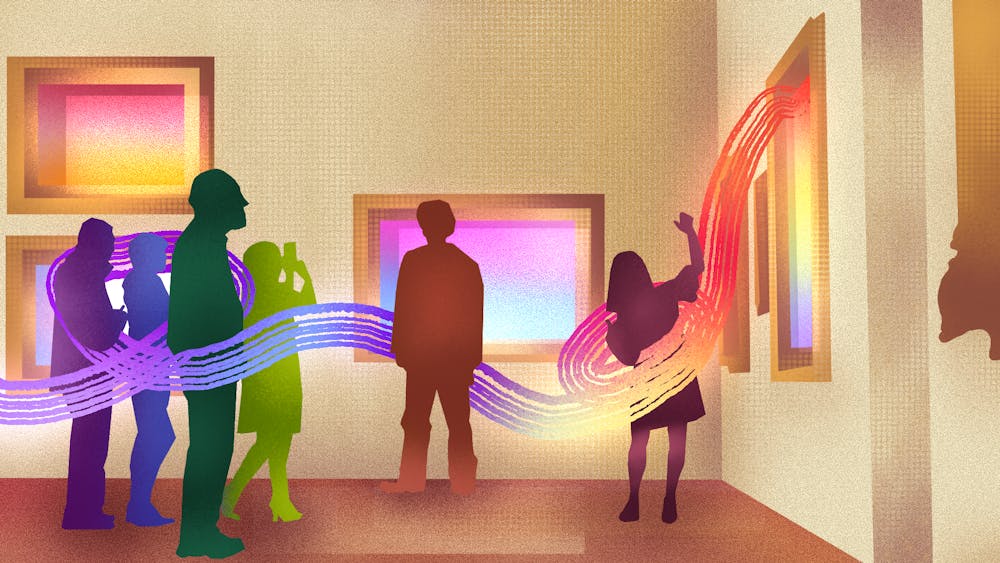Visibility is a certain tyranny: We should question how ways of seeing the world are constructed in order to draw our gaze to certain things. Why are only certain artists made visible to us? Certain works? It is through visibility—an alternate visibility—that a certain displacement of the status quo occurs, a displacement away from the expected ways of seeing, towards youthful creativity where new art is championed unabashedly.
Rochester, N.Y. is a vibrant city for artisans, brewers, coffee roasters, and farmers. It is also a hub for art spaces, from renowned theaters to symphony orchestras. Local schools have budding fine arts talent, the pool which Spectra, an LGBTQ+ centered youth art show, draws from. Run by TGW Studio, an “LGBTQ+/non-binary/women-owned and -operated social impact creative and marketing firm,” Spectra is in its third year of presenting new artists and their work. This year, the artists displayed stunning originality and passion, along with a distinct joy for creating, a joy they hope to share with as many as possible.
The goal of the show is to “Honor those young LGBTQ+ voices that don't necessarily get the spotlight a lot of times,” says Emily VanDerEems, the brand manager at TGW. She notes that Spectra was initiated to showcase the vibrant creativity witnessed firsthand in Rochester. During Pride Month, TGW wants to do something beyond marching: They want to put young creators directly into view of the citizenry. In fact, they want to do this all year round.
This year, the show’s donations went to support the Center for Youth, a program founded by local high school students in 1971 to help kids form positive life choices. The Center provides runaway, housing, and crisis services, in addition to restorative activities and school programming.
“You're doing art, it's trial and error, mostly. You're going to have pieces that you hate, and you're going have pieces that you love. So just keep trying.” This bit of wisdom, far–ranging in its applications beyond art, comes from Maddie Keller, one of the artists featured this year. They create through different mediums, with makeup being this year's focus.
Maddie wants their audiences to feel happy while viewing their art. Since they were young, they have been creating, a practice that helps Maddie channel anxiety through an interpretive world. The vibrant display reminds one of the pride rainbow, the spectrum of colors uninhibited by strictures, free to mingle and create new constellations.

A different Maddie, Maddie Zebrak, sees art as both fun and expressive. She channels emotions into each piece, which renders a distinctive personal fingerprint. This year, her self–portraits drew significant attention, being focal points on the gallery wall.
Maddie likes to first sketch her pieces, then spread over the rough outline with a fine layer of color, a technique known as “wash.” After this layer, Maddie lets her artistic intuition take over, bouncing back and forth between colored pencils and more wash. Maddie notes that she will “never stop creating,” and wants art to be a career for her.

For aspiring artist Violet Morahan, art is tied to gender expression. “I never really knew where I was in the world until a couple of years back. It took me a while to really find the processes of who I was, and with my pieces, I really convey that,” they say. “I think once I set it, every color just has an emotion to it … my pieces are a million combined in one, and you can really take from it that depth.” This depth of color and emotion is immediately evident in pieces like The Mind’s Eye.
For Violet, the piece of art is an open site, never allowing itself to be closed off with an answer. In many ways, this is analogous to their experience with gender and self–expression. They intimate that art “was a flame that lit my fuse of identity … And when I look into art pieces, I really try to find the feng shui in it all. I hate not having a balance in life.” But beyond this balance comes a burst of chaotic energy that fuels the act of creation.
Violet’s process for their work is self–described as unconventional and spontaneous, especially in the case of The Mind’s Eye. “I went up to the product cabinet. I grabbed about 20 different colors … and I set my canvas out. I sat there for two seconds and said, ‘Let's do this.’ And by the end of the first period … I had this really unconventional, really different type of painting. The second day, once again, it completely changed,” they say. This continuous process of creating and experimenting with colors continues until Violet believes the piece is done. But in many ways, the piece is never really done—it’s always an ongoing process. Art, like life, is a process of endless becoming, of options, and of chance.

Moon Rose Albro likes to make art based on connections with others. “Usually, the art that I express has a sentimental tie. Whether it's a cat that passed, or something that my friend and I share, or a gift for someone,” they say. “It just brings me joy to see other people have this happy reaction to the things that I create.”
Their main piece this year is a clay horse that was inspired by a video game played with a friend. Moon also gifts pieces to teachers and family members.
Moon has also seen a progression of their identity through art. “My teachers have helped me understand … my voice, and my journey from trying to figure out who I am, because when I look back at my older art, I’m like, ‘Who is this person? Where did they come from?’ And then I can definitely tell … that I've grown.” Moon’s process of finding their voice faces challenges from the inside. They struggle with letting others interpret, so Moon likes to create in a style of realism, making their ideas as clear as possible in the given medium.

One thing that ran like a bright splash of paint through Spectra was a feeling of joy. Artists and families were proud of the work and admired the ingenuity flourishing on the walls. Everyone basked in the light—not of the sun, but the light which has the capacity to bring a change of perspective to the eye. What is normally exposed to us was displaced, revealing a glorious cache which otherwise would have been hidden from sight.
This alternate sight was a breath of fresh air for the community. A prideful air radiates around Spectra, one that's less transient than a march, more permanent than a protest, and carries with it hints of the future.

